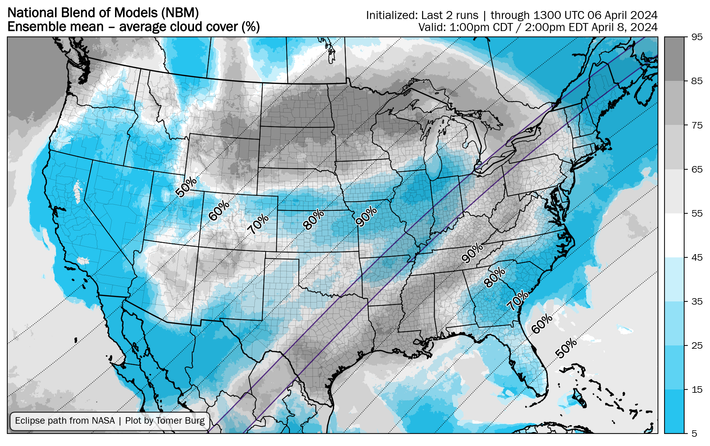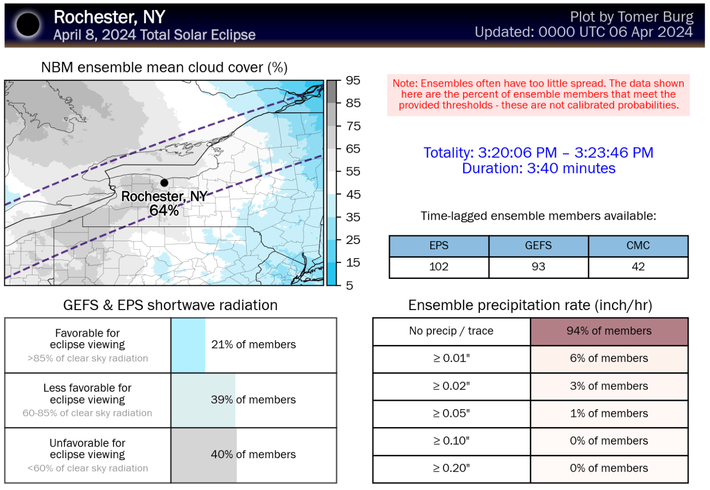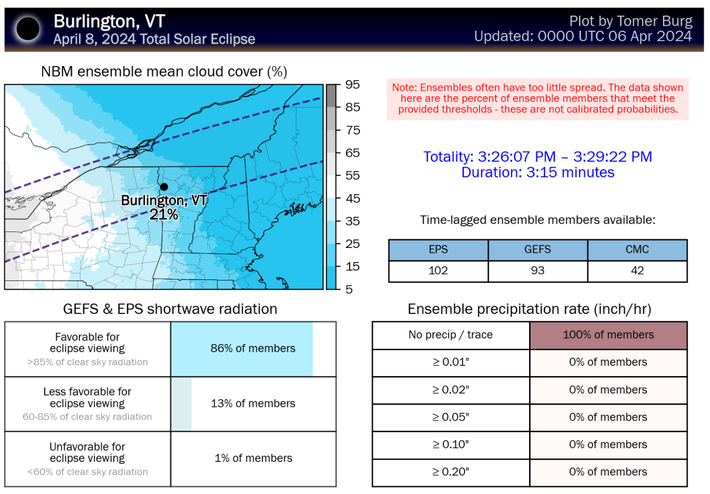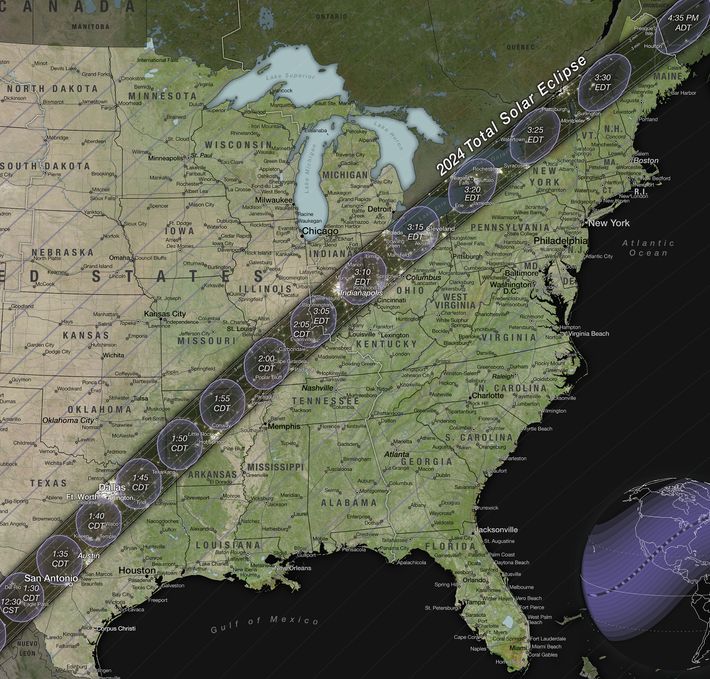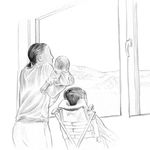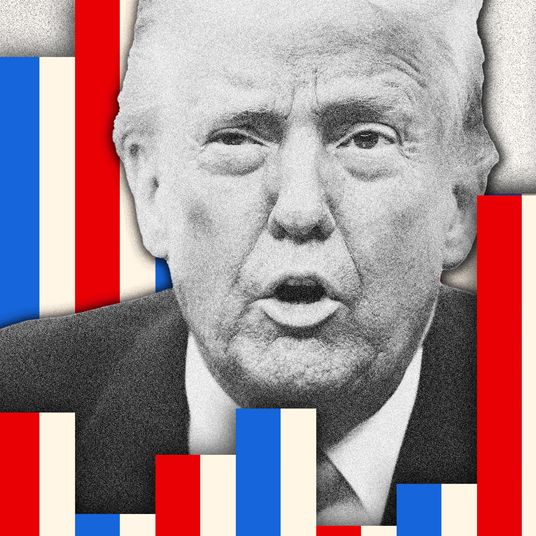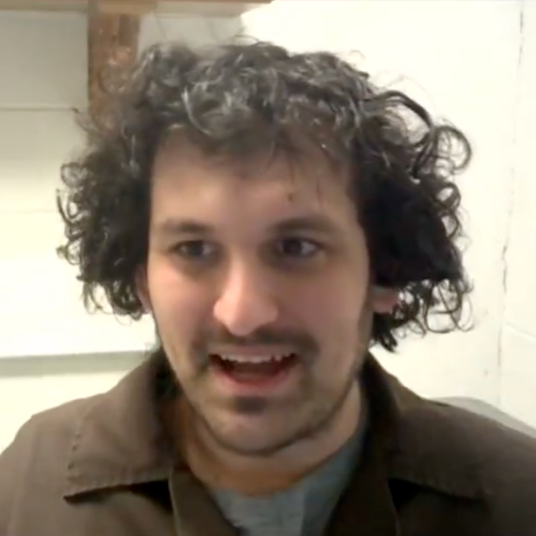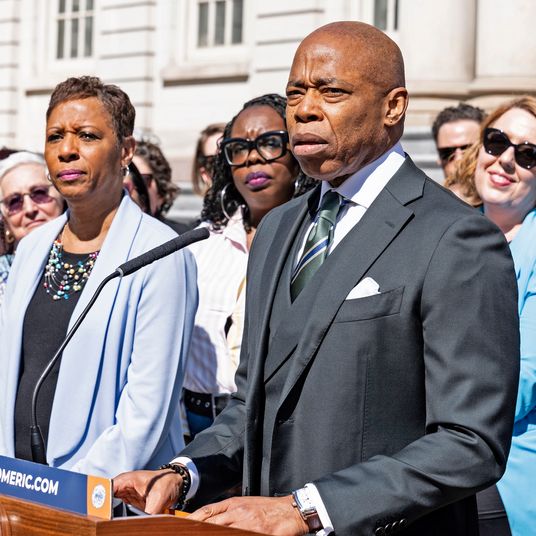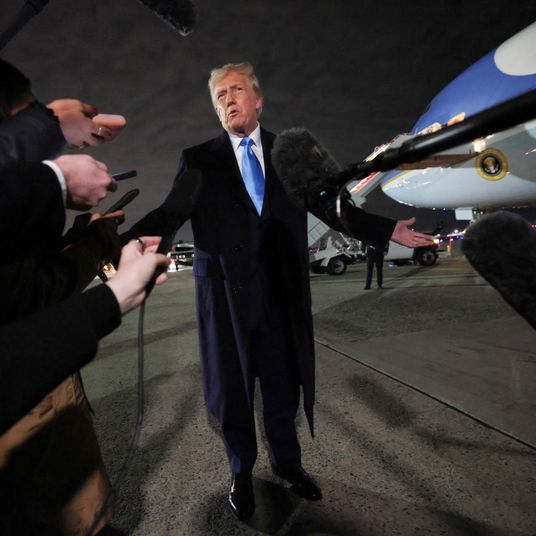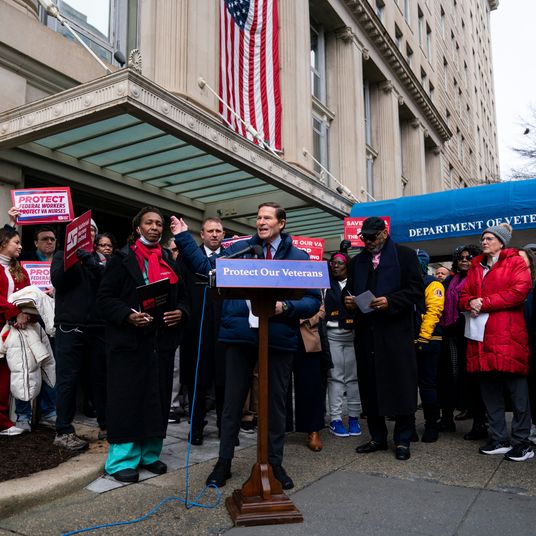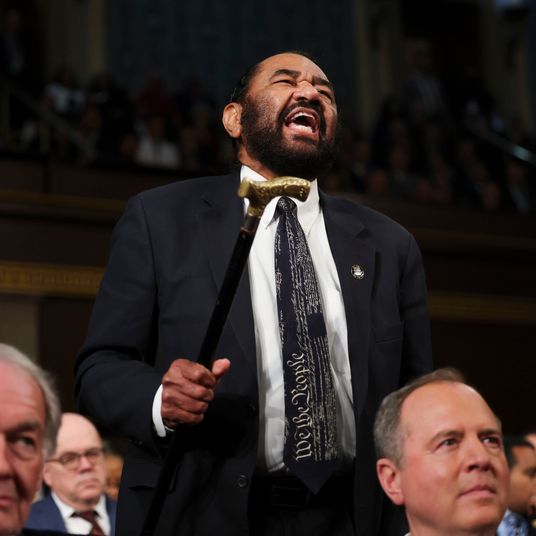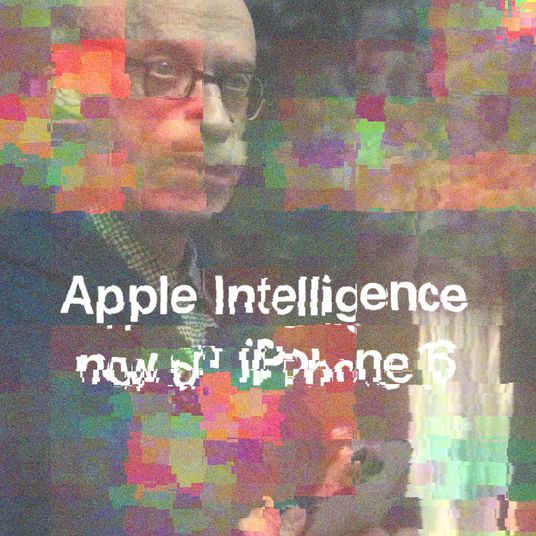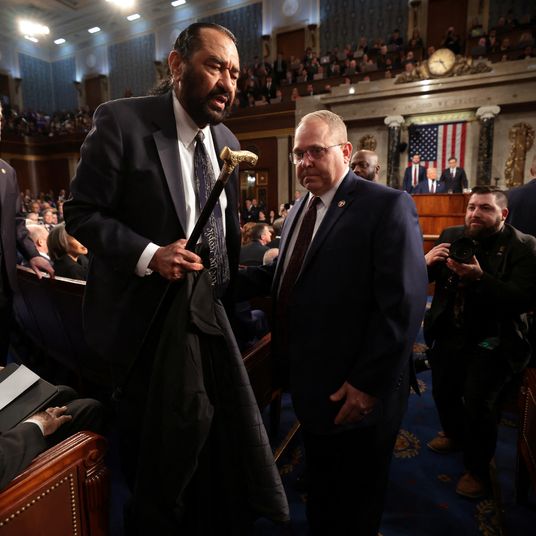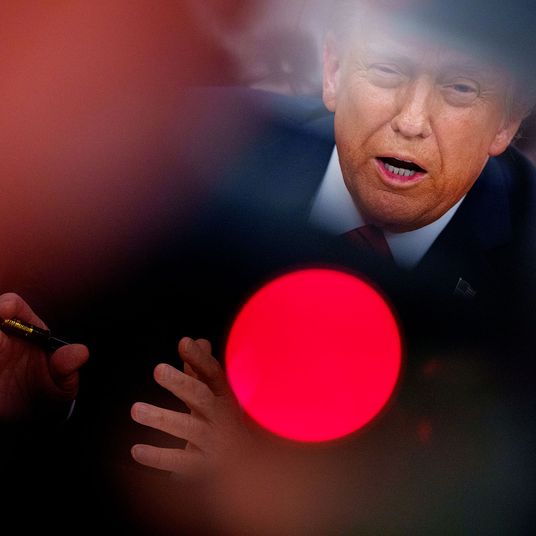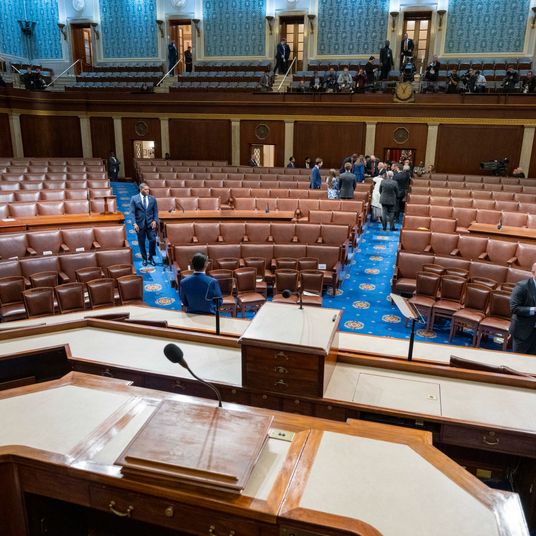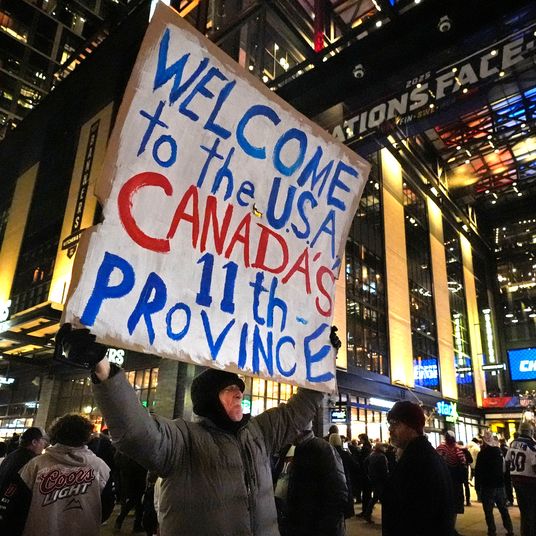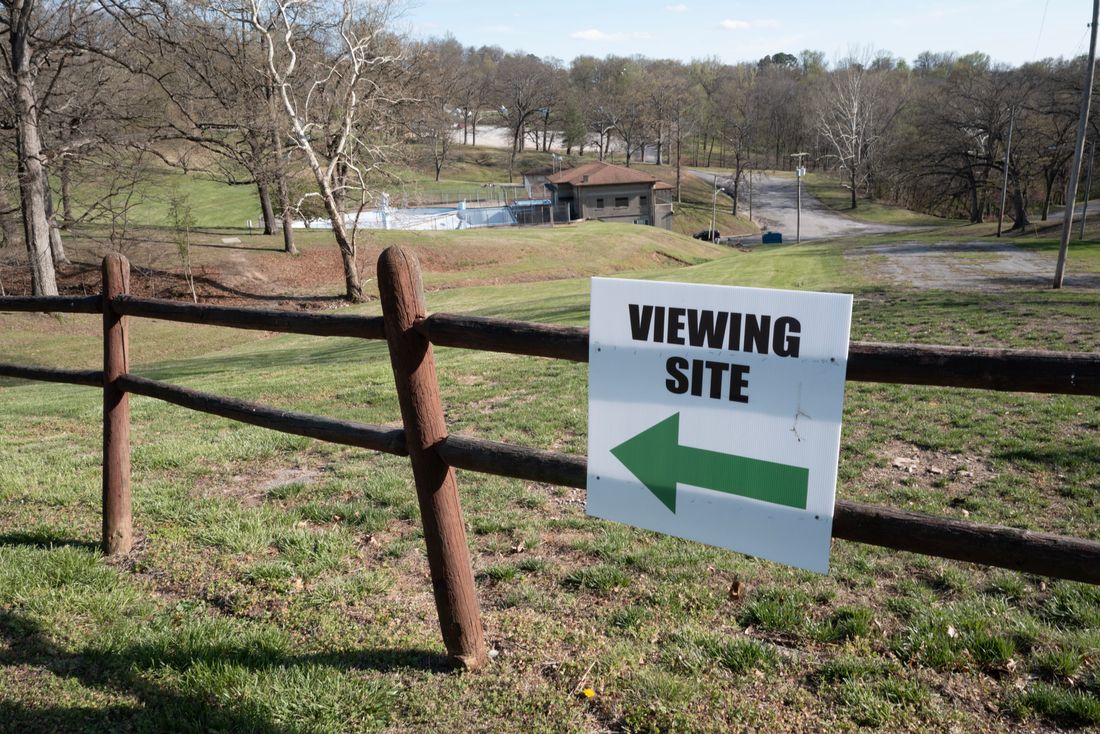
The totality is coming. On Monday, April 8, millions of Americans across multiple states will be able to see the total solar eclipse — a rare celestial event which won’t be viewable in the continental U.S. again for another few decades. For earthquake-rattled New Yorkers aiming to view the event — or more specifically, the partial event here from the city — Curbed has put together a helpful guide. The Strategist has recommendations on how not to go blind (by wearing solar eclipse glasses). And the Cut all the astrology angles covered. Here at Intelligencer, we’ll be keeping you up to date on all the latest weather reports, last-minute preparations, commentary and analysis, and general pre-eclipse mania over the weekend.
The latest eclipse-path weather report
It’s looking about the same as it did on Saturday: there should be good viewing weather in some but definitely not all of the path (for the totality) in the U.S., as CNN reports:
The most ideal weather for the eclipse will likely occur in two general areas: from Vermont through Maine, as well as Missouri through southern Indiana. Only a few isolated clouds are expected for these areas, which should not prevent optimal eclipse viewing. So get your eclipse glasses ready for places like Evansville, Ind.; Carbondale, Ill.; Burlington, Vt.; and Caribou, Maine.
Some of the locations with less-than-ideal weather include portions of the eastern Great Lakes and much of Texas.
Cleveland, Ohio, and Erie, Penn., have a chance of rain mainly in the morning, but scattered cloud cover may be slow to exit the area even after the rain ends. The extent of the cloud cover all hinges on how quickly a warm front advances eastward.
Farther east in Buffalo and Rochester, New York, cloud cover is expected to be between mostly cloudy and overcast — which will limit the viewing of the eclipse pretty significantly.
Behold the cereal box eclipse viewer
For anyone who doesn’t have the special glasses some other eclipse viewing device, you can also use a cereal box, CBS News explains:
If you want to make your indirect viewing tool a bit more elaborate, you can make an eclipse viewer with a few more materials around the house. Here’s how:
• Find a small box (popular options are cereal and shoe boxes)
• Cut two openings at the bottom of the box
• Using tape, cover one of the openings with a piece of paper or aluminum foil punctured with a small pinhole
• Face away from the sun, allowing the light to hit the pinhole
• Looking through the remaining opening to the inside of the box, watch as the sun projection goes from a complete circle to an eclipse
Just keep in mind, you’ll need to eat a box of cereal on Monday morning to be able to do this.
Don’t feel total regret over only seeing the partial eclipse
At Slate, Shannon Palus reminds everyone not planning a trek to the path of the totality that they can still do some solid celestial marveling on Monday:
The entire U.S. will be experiencing a partial solar eclipse. Just watch that! It may not be as cool, but it will be cool too. …
[A] partial eclipse is not the same experience as a full one. But will the partial eclipse be a lesser experience? Only if you evaluate it in terms of a three-ish-minute span of time, the length of time the sun will be covered by the moon in the path of totality (though this amount is even less in some places that are still in the totality). What if you include all of the surrounding time, effort, money, and travel that it will take to get to having those three-ish minutes in that place?
The current cloud cover outlook
Tomer Burg, a PHD candidate in atmospheric science at the University of Oklahoma, is sharing the latest weather models regarding estimated cloud cover and precipitation along the path of the totality for Monday afternoon, including city-specific dashboards.
Below is the latest “ensemble mean cloud cover” model. Notes Burg, “Especially more than 2-3 days away from the eclipse, an ensemble mean won’t show the actual expected cloud cover, but rather gives an indication as to whether clear or cloudy skies are favored.” The path of the totality is between the purple lines, and the blue areas have less estimated cloud cover, and the gray areas have more (bad):
So as of early Saturday, there may end up being a lot of disappointed eclipse viewers in Texas and western New York State, while people in the midwest and northern New England may luck out. Here’s the current estimated outlook for Rochester, New York, per Burg’s site, as one example:
And here’s Burlington, Vermont:
How many Americans will see this thing?
According to NASA, an estimated 31 million people live within the path of the totality, but 150 million people (about 45 percent of the U.S. population) live within 200 miles of the path. That doesn’t include total eclipse tourists from other parts of the country, or people who will be able to see a partial eclipse.
What time is the eclipse?
Monday afternoon, but the specific time obviously varies depending on where you are in the country along the path. Here’s NASA’s map with the corresponding times when the totality will be viewable, where:
But could the path maps be a little off?
Maybe, at the edges of the path where you don’t want to try to watch it, anyway. Reports CNN:
New map calculations have raised some concerns that the path of totality — where it’s possible to see the moon completely block out the sun — is slightly narrower than NASA calculated. That means some cities on the edge of the route that were expecting to experience a second or two of total darkness might be left out. NASA has not changed its predictions, but the space agency advises that there is some uncertainty involved in mapping the eclipse’s path.
“Calculations that use a slightly larger radius for the size of the Sun yield an eclipse path that is slightly narrower,” said NASA spokesperson Karen Fox in an emailed statement. “This difference would only affect cities on the very edge of the path of totality, where blanket predictions are difficult regardless — a few city blocks one way or the other could mean 20, 10, or 0 seconds of totality.”
And for viewing purposes, NASA scientists and other experts recommend that spectators head for the middle, rather than the perimeter, of the path anyway.
Don’t stare at the sun through cheap knockoff eclipse-viewing glasses!
It’s already getting late to pick up some glasses to avoid being a Donald Trump and burning your eyes staring at the sun. But if you are still looking for a pair, do not assume that some random brand is going to protect you. The American Astronomical Society has specifically advised Americans not to purchase from large marketplaces where counterfeits may be sold, unless they definitely know the glasses they’re buying are certified and from a reputable seller: “We do not recommend searching for eclipse glasses on Amazon, eBay, Temu, or any other online marketplace and buying from whichever vendor offers the lowest price. Before you buy a solar viewer or filter online, we recommend that you make sure that the seller is identified on the site and the seller is listed on this page.”
Again, the Strategist has a complete guide to the safe glasses here.
No, the world isn’t going to end
But our Rapture correspondent, Sarah Jones, definitely felt the pull of Scripture, at least temporarily, after a pre-eclipse East Coast earthquake rumbled through New York City on Friday morning:
We had floods earlier this week. A solar eclipse is imminent, as is a plague of locusts. Eric Adams is the mayor. It’s all very troubling! …
I’m not sure our 4.8-magnitude tremor meets the standards set by Revelation. Not to downplay everyone’s feelings, of course. We all need something to talk about. We are all desperate for a distraction from work. But I did not hear any voices, and we all seem to be alive, so I think that divine judgment might not be upon us. Yet. Look, if you grew up the way I did (isolated and Evangelical in the American South), then you know from countless pastors that the End Times has been on the way since Christ returned to heaven. Maybe Friday’s earthquake changes little. Maybe it’s just a little nudge from God — to read your dang Bible, or text your ex, or whatever. God! He’s such a diva.



